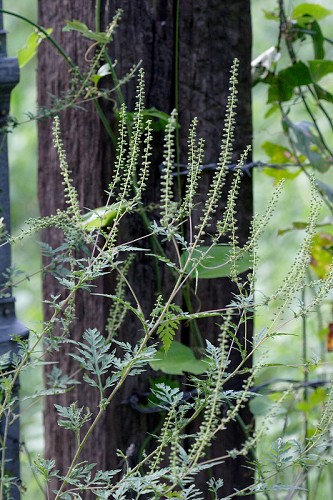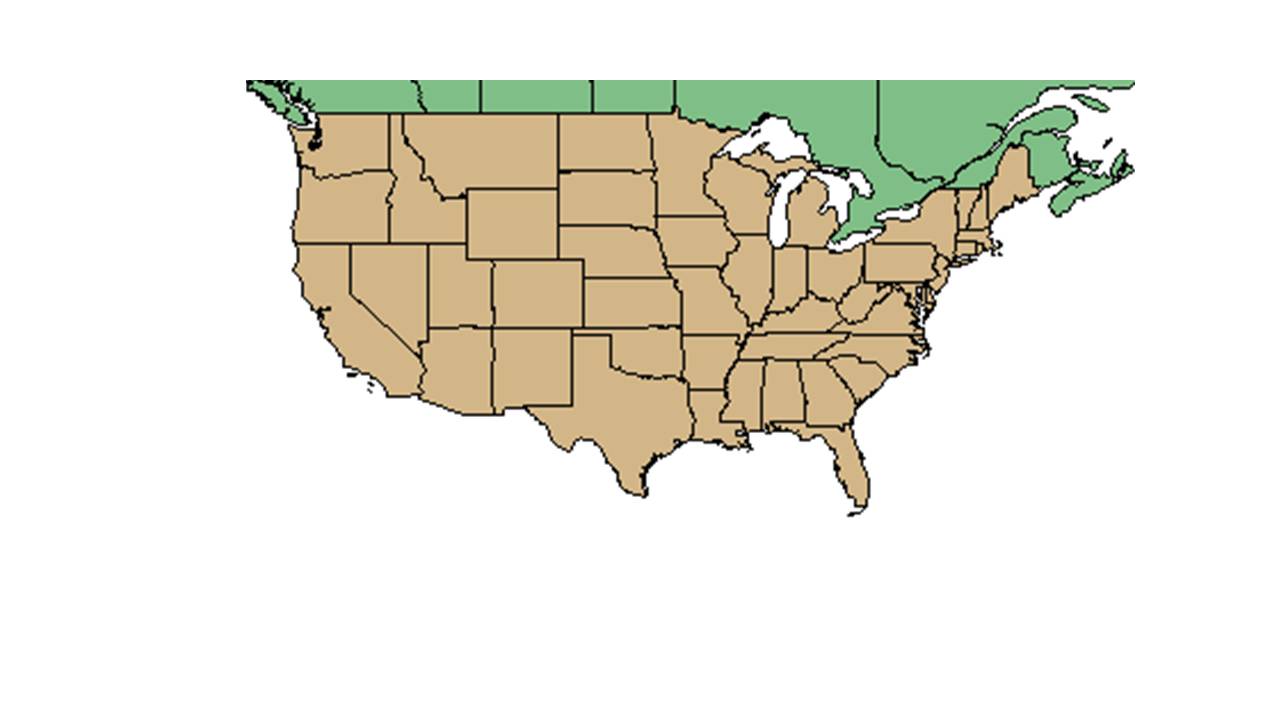Difference between revisions of "Ambrosia artemisiifolia"
(→Seed bank and germination) |
|||
| Line 51: | Line 51: | ||
===Use by animals===<!--Herbivory, granivory, insect hosting, etc.--> | ===Use by animals===<!--Herbivory, granivory, insect hosting, etc.--> | ||
| − | ''A. artemisiifolia'' is one of the most important plant species for food and cover-producing for Northern Bobwhite.<ref name= "Miller"> Miller, J. H. and K. V. Miller (1999). Forest plants of the southeast, and their wildlife uses Champaign, IL, Southern Weed Science Society. </ref> The seeds are also consumed by various songbirds, the thirteen line ground squirrel, meadow vole, and prairie vole.<ref name="illinois"/> It is a common plant for White-tailed deer to browse in the Spring and Summer months.<ref name= "Miller"/><ref name= "Atwood">Atwood, E. L. (1941). "White-tailed deer foods of the United States." The Journal of Wildlife Management 5(3): 314-332.</ref> The following caterpillars eat the foliage, flowers and seeds: ''Schinia rivulosa'' (Ragweed flower moth), ''Synchlora aerata'' (Wavy lined emerald), ''Tarachidia erastrioides'' (small bird dropping moth), and ''Tarachidia candefacta'' (olive shaded bird dropping moth).<ref name="illinois"/> | + | ''A. artemisiifolia'' is one of the most important plant species for food and cover-producing for Northern Bobwhite.<ref name= "Miller"> Miller, J. H. and K. V. Miller (1999). Forest plants of the southeast, and their wildlife uses Champaign, IL, Southern Weed Science Society. </ref> The seeds are also consumed by various songbirds, the thirteen line ground squirrel, meadow vole, and prairie vole.<ref name="illinois"/> It is a common plant for White-tailed deer to browse in the Spring and Summer months.<ref name= "Miller"/><ref name= "Atwood">Atwood, E. L. (1941). "White-tailed deer foods of the United States." The Journal of Wildlife Management 5(3): 314-332.</ref><ref name= "Gee">Gee, K. L., et al. (1994). White-tailed deer: their foods and management in the cross timbers. Ardmore, OK, Samuel Roberts Noble Foundation.</ref> The following caterpillars eat the foliage, flowers and seeds: ''Schinia rivulosa'' (Ragweed flower moth), ''Synchlora aerata'' (Wavy lined emerald), ''Tarachidia erastrioides'' (small bird dropping moth), and ''Tarachidia candefacta'' (olive shaded bird dropping moth).<ref name="illinois"/> |
===Diseases and parasites=== | ===Diseases and parasites=== | ||
Revision as of 17:39, 5 March 2019
| Ambrosia artemisiifolia | |
|---|---|

| |
| Photo by John R. Gwaltney Southeastern Flora.com | |
| Scientific classification | |
| Kingdom: | Plantae |
| Division: | Magnoliophyta - Flowering plants |
| Class: | Magnoliopsida – Dicotyledons |
| Order: | Asterales |
| Family: | Asteraceae ⁄ Compositae |
| Genus: | Ambrosia |
| Species: | A. artemisiifolia |
| Binomial name | |
| Ambrosia artemisiifolia L. | |

| |
| Natural range of Ambrosia artemisiifolia from USDA NRCS Plants Database. | |
Common name: Common ragweed
Contents
Taxonomic notes
Synonyms: A. artemisiifolia Linnaeus var. elatior (Linnaeus) Descourtils; A. artemisiifolia Linnaeus var. paniculata (Michaux) Blank; A. artemisiifolia Linnaeus var. artemisiifolia; A. elatior Linnaeus; A. monophylla (Walter) Rydberg; A. glandulosa Scheele
Description
Annual. Are rhizomatous, perennial herb with pubescent stems and usually freely branched. The leaves are opposite, the upper are alternate, linear, 1-4.5cm long, 0.5-3mm wide, entire, the base are attenuate, and pubescent on both surfaces. The petioles are obscured by decurrent blade tissues. The racemes are 3-20cm long. The involucres are 1.5-3mm long. The nutlets are black in color, are pubescent at the apex, obovoid in shape, turgid, and 1.6-2.1mm long. Flowers September to October.[1]
Annual. Grows 0.2-2m tall, with a taproot. Has freely branched stems. The leaves are deeply bipinnately dissected with acute sinuses, the lower are opposite, the upper are alternate, 5-15cm long. The segments are mostly less than 1cm wide and are acute. The pistillate involucres are fascicled in upper leaf axils, obovoid in shape, pubescent to glabrate, 2.5-3.5mm long, 1.5-2.5mm in diameter, angulate, each with 5-6 rarely fewer, erect projections toward the apex. The staminate heads are 2-4mm broad, irregularly more or less 5-lobed, peduncles 1-6mm long. The nutlets are brown in color and 3-3.5mm long. Flowers August to frost.[1]
Distribution
A. artemisiifolia is distributed across the continental United States as both a native and introduced species, and is native to almost all provinces of Canada. It has also been introduced to Hawaii. [2]
Ecology
Habitat
It is common throughout Florida.[3] and throughout the entire United States.[4] It has been found in open pine woods, mixed hardwoods, wet hammocks, and along dried up shores of ponds. It does well in a number of disturbed areas including old fields, drainage ditches, pastures, roadsides, sandy vacant lots, railroad gravel, blackland prairie soil, camping areas, wet pastures, levees, drainage ditches, along edges of mixed forests, recently disturbed boggy areas, along canals, and agricultural fields. It thrives in dry sandy soils to wet, peaty soils in high intensity light in open areas.[5]
Associated species include Agalinis divaricata, pine, hickory; Euphorbia, Andropogon, Bidens, Paspalum urvillei, P. notatum, Eragrostis oxylepis, Eleusine indica, Digitaria sanguinalis, Cyperus surinamensis, Ambrosia artemisifolia, Strophostyles helvola, Solanum americanum, S. sisymbriifolium, Daubentonia drummondii, Sesbania exaltata, cabbage palmetto, Emilia fosbergii, Paspalum setaceum, Heterotheca subaxillaris, Boerhavia diffusa, Bothriochloa ischaemum; Croton capitatus and various grasses.[5]
Phenology
Ambrosia artemisiifolia has been observed to flower between April and June to November and fruits from summer to late fall.[3][5][6]
Seed dispersal
Seeds are distributed by animals,[7] but this species is also thought to be dispersed by wind.[8]
Seed bank and germination
It has a persistent seedbanks that can remain in the soil even after years of disturbance.[9] Seeds require an after-ripening period before germination occurs; germination occurs after near freezing temperatures.[10] The initial dormancy of A. artemisiifolia can be attributed to presence of inhibitors like phenolic compounds and abscissic acid.[11]
Fire ecology
It can live where winter-burned annually and has been found in firelanes of annually-burned pinelands.[5][12] While fire increases the amount of bare ground, this in turn decreases competition and allows weedy forbs like A. artemisiifolia to greatly increase in numbers.[13]
Use by animals
A. artemisiifolia is one of the most important plant species for food and cover-producing for Northern Bobwhite.[14] The seeds are also consumed by various songbirds, the thirteen line ground squirrel, meadow vole, and prairie vole.[7] It is a common plant for White-tailed deer to browse in the Spring and Summer months.[14][15][16] The following caterpillars eat the foliage, flowers and seeds: Schinia rivulosa (Ragweed flower moth), Synchlora aerata (Wavy lined emerald), Tarachidia erastrioides (small bird dropping moth), and Tarachidia candefacta (olive shaded bird dropping moth).[7]
Diseases and parasites
The pathogenic fungus Albugo tragopogi (white rust fungus) attacks ragweed and decreases pollen production. It is used as a control agent to limit the amount of ragweed allergens.[17]
Conservation and management
Ragweed is a common allergen. The pathogenic fungus Albugo tragopogi (white rust fungus) can be used as a control agent to limit the amount of ragweed pollen produced.[17] A. artemisiifolia is listed as a noxious weed within city limits in the state of Illinois, and listed as a "B" designated weed and quarantined in the state of Oregon.[2]
Cultivation and restoration
Photo Gallery
References and notes
- ↑ 1.0 1.1 Radford, Albert E., Harry E. Ahles, and C. Ritchie Bell. Manual of the Vascular Flora of the Carolinas. 1964, 1968. The University of North Carolina Press. 1016-1018. Print.
- ↑ 2.0 2.1 USDA Plants Database URL: https://plants.usda.gov/core/profile?symbol=ANGE
- ↑ 3.0 3.1 Wunderlin, Richard P. and Bruce F. Hansen. Guide to the Vascular Plants of Florida. Second edition. 2003. University Press of Florida: Gainesville/Tallahassee/Tampa/Boca Raton/Pensacola/Orlando/Miami/Jacksonville/Ft. Myers. 296. Print.
- ↑ Hall, David W. Illustrated Plants of Florida and the Coastal Plain: based on the collections of Leland and Lucy Baltzell. 1993. A Maupin House Book. Gainesville. 74. Print.
- ↑ 5.0 5.1 5.2 5.3 Florida State University Robert K. Godfrey Herbarium database. URL: http://herbarium.bio.fsu.edu. Last accessed: June 2014. Collectors: Loran C. Anderson, Tom Barnes, R. Barbezat, Sarah Beem, S. Bennett, Kurt E. Blum, Michael B. Brooks, R. C. Darby, Frank DiCecco, William B. Fox, Mary A. Garland, Robert K. Godfrey, Bruce Hansen, G. G. Hedgcock, Norlan C. Henderson, Brenda Herrig, C. Jackson, T. Kanno, Robert Kral, Gary R. Knight, Elmo Law, Martha Lee, S. W. Leonard, S. J. Lombardo, C. L. Lundell, Travis MacClendon, Karen MacClendon, Sidney McDaniel, Richard S. Mitchell, J. B. Morrill, John B. Nelson, R. A. Norris, H. Okazaki, Dan Pittillo, A. E. Radford, Lloyd H. Shinners, Cecil R. Slaughter, Bill Stangler, William R. Stimson, Amanda R. Travis, Charles S. Wallis, Keenan Windler, and Wendy Zomlefer. States and Counties: Alabama: Baldwin. Colorado: Jefferson. Florida: Brevard, Columbia, Dade, Escambia, Franklin, Indian River, Jackson, Jefferson, Leon, Liberty, Okaloosa, Pasco, Polk, Putnam, and Wakulla. Georgia: Colquitt, Decatur, Fulton, Grady, and Thomas. Illinois: Coles, Cook, and Lawrence. Iowa: Fremont. Louisiana: Ouachita. Kansas: Riley. Maryland: Baltimore. Mississippi: Harrison and Oktibbeha. Missouri: Cass, Greene, and Ray. North Carolina: Ashe, Chowan, Macon, Madison, and Wayne. Oklahoma: Ottawa. Pennsylvania: Huntingdon. South Carolina: Dorchester, Lexington, and Richland. Tennessee: Grundy and Polk. Texas: Dallas. Virginia: Giles, Montgomery, and Van Zandt. Other countries: Japan.
- ↑ Nelson, G. PanFlora: Plant data for the eastern United States with emphasis on the Southeastern Coastal Plains, Florida, and the Florida Panhandle. www.gilnelson.com/PanFlora/ Accessed: 7 DEC 2016
- ↑ 7.0 7.1 7.2 [[1]]Illinois Wildflowers. Accessed: March 29, 2016
- ↑ Kirkman, L. Katherine. Unpublished database of seed dispersal mode of plants found in Coastal Plain longleaf pine-grasslands of the Jones Ecological Research Center, Georgia.
- ↑ Rothrock, P. E., E. R. Squiers, et al. (1993). "Heterogeneity and Size of a Persistent Seedbank of Ambrosia artemisiifolia L. and Setaria faberi Herrm." Bulletin of the Torrey Botanical Club 120(4): 417-422.
- ↑ Bazzaz, F. A. (1970). "Secondary Dormancy in the Seeds of the Common Ragweed Ambrosia artemisiifolia." Bulletin of the Torrey Botanical Club 97(5): 302-305.
- ↑ Dinelli, G., et al. (2013). "Germination ecology of Ambrosia artemisiifolia L. and Ambrosia trifida L. biotypes suspected of glyphosate resistance." Central European Journal of Biology 8: 286-296.
- ↑ Bakelaar, R. G. and E. P. Odum (1978). "Community and population level responses to fertilization in an old-field ecosystem." Ecology 59: 660-665.
- ↑ Curtis, J. T. and M. L. Partch (1948). "Effect of fire on the competition between blue grass and certain prairie plants." American Midland Naturalist 39: 437-443.
- ↑ 14.0 14.1 Miller, J. H. and K. V. Miller (1999). Forest plants of the southeast, and their wildlife uses Champaign, IL, Southern Weed Science Society.
- ↑ Atwood, E. L. (1941). "White-tailed deer foods of the United States." The Journal of Wildlife Management 5(3): 314-332.
- ↑ Gee, K. L., et al. (1994). White-tailed deer: their foods and management in the cross timbers. Ardmore, OK, Samuel Roberts Noble Foundation.
- ↑ 17.0 17.1 Hartmann, H. and A. K. Watson (1980). "Damage to Common Ragweed (Ambrosia artemisiifolia) Caused by the White Rust Fungus (Albugo tragopogi)." Weed Science 28(6): 632-635.